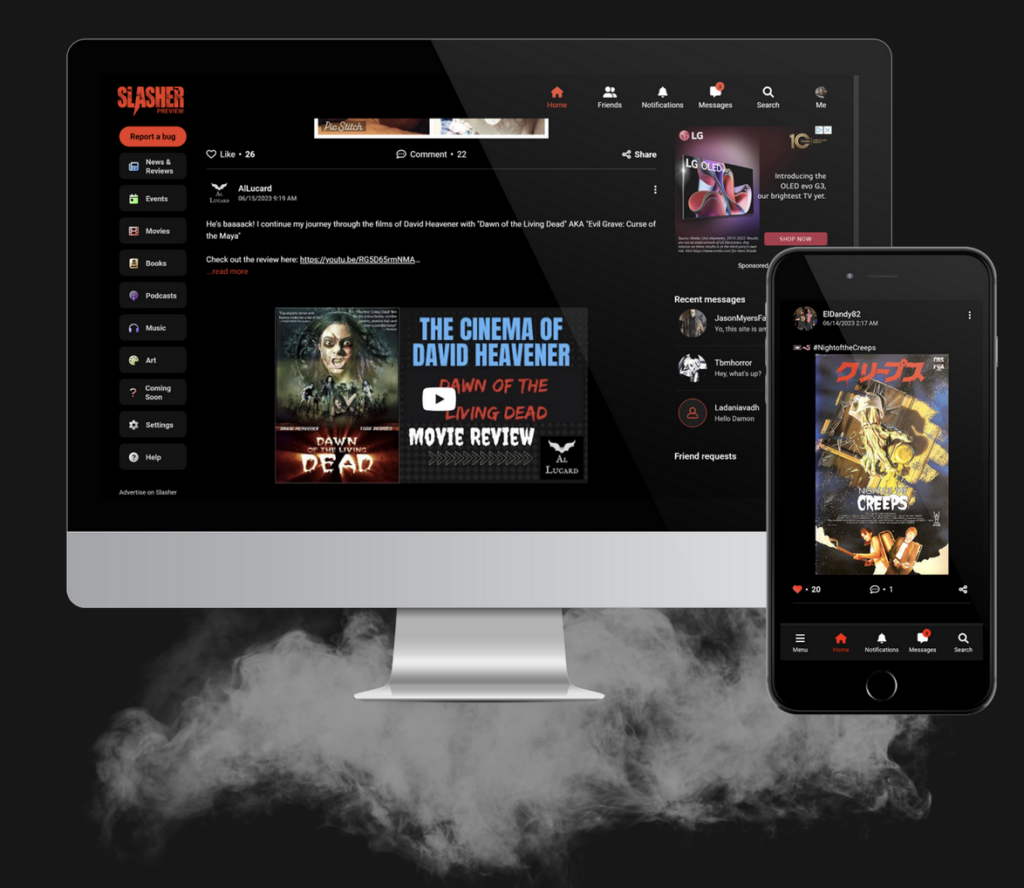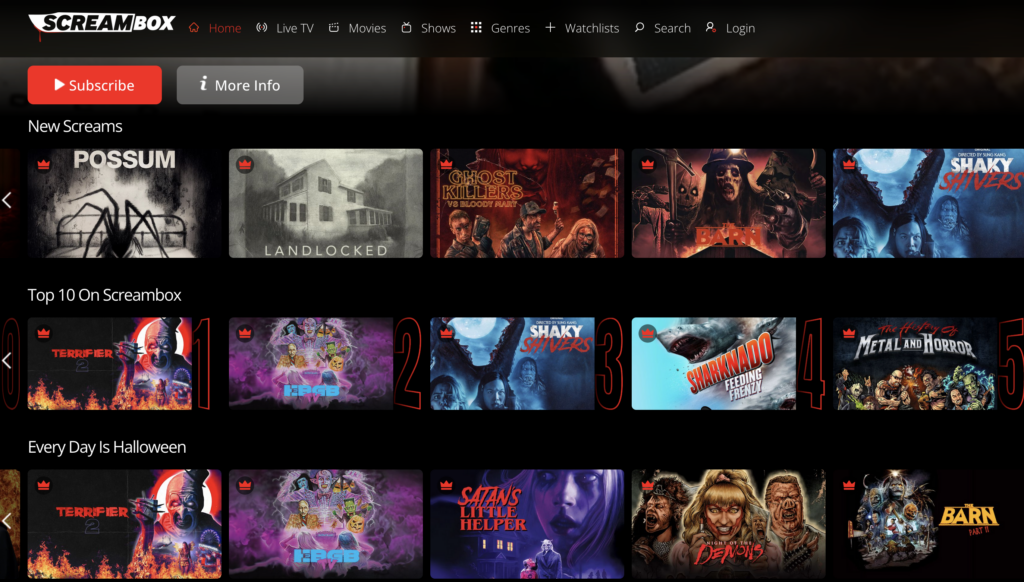In a time where technology and horror intersect, the thrill of the unknown has found a new home in our phones. For those of us who thrive on the spine-tingling, heart-pounding experiences, the world of horror apps offers an entirely different dimension of chills and thrills. From horror social media apps, streaming apps, to some great horror app games we’ve delved deep into the eerie abyss of the app stores to bring you a curated list of the best horror apps for true horror enthusiasts.
Social Apps
This category has had a rough ride lately with Twitter (Now X) having an identity crisis and AI bots not having a clue what the difference is between people talking about horror and people being horrible. Two apps standout in their ability to let the horror community be who they are talking about movies, books and all things creative horror without confusing the issues of real life horrors.
Slasher App

Slasher was built for horror fans! Now you can enjoy a friendly community with no censorship of bloody or gory special effects and makeup! Want to connect with other horror fans? Slasher makes it possible to make connections faster than any other social platform! The people behind Slasher are horror fans too! Available on Iphone, Android, and Desktop
You can find us there @puzzlebox
r/Horror
The horror subreddit on Reddit is a virtual haven for fans of all things macabre and spine-tingling. This thriving community is where horror enthusiasts, both casual and die-hard, come together to share and discuss their love for the genre. From chilling stories and terrifying urban legends to eerie photos and spine-tingling artwork, the horror subreddit is a treasure trove of everything that goes bump in the night. Users can post their own original horror content, engage in discussions about favorite horror films, books, and games, and seek recommendations for the best scares in the genre. With a diverse and passionate user base, the subreddit serves as a communal campfire for those who relish the thrill of fear and enjoy delving into the darkest corners of the human imagination. Whether you’re a horror writer looking for inspiration or a horror film fanatic seeking hidden gems, Reddit’s horror subreddit is the perfect place to embrace the darkness.
Horror Movie Apps
Shudder
Shudder is the ultimate streaming platform for horror aficionados, catering to those who crave a constant dose of spine-tingling and chilling content. This specialized app offers a vast and ever-expanding library of horror films, series, documentaries, and original content, making it a go-to destination for all things terrifying. From classic horror masterpieces to cutting-edge, exclusive releases, Shudder curates a diverse selection to satisfy every horror enthusiast’s appetite. With its dedication to the genre, Shudder ensures that subscribers can experience horror in its many forms, from supernatural to psychological, providing a nightmarish journey that’s both thrilling and horrifying.
Screambox

Screambox is a dedicated streaming service designed to terrify and delight horror fans. This platform curates a vast collection of horror films, TV shows, and original content, offering a one-stop destination for all things eerie and spine-tingling. With a wide range of horror sub-genres, from classic slashers to supernatural thrillers, Screambox caters to every taste in the horror world. It’s the perfect haunt for those who seek a constant supply of scares and a diverse array of fear-inducing content, ensuring that subscribers can experience the best and darkest offerings in the horror genre. Screambox is known to have original content you cannot find elsewhere. It’s a Scream!
Shout TV
Shout TV’s horror offerings are a spine-tingling treasure trove for fans of the genre. With a vast collection of classic and cult horror films, as well as hidden gems and iconic series, Shout TV is your go-to source for all things chilling, macabre, and favors the campy side of horror.
Horror App Games for Phones
Simulacra
Ever wondered what would happen if you stumbled upon someone’s lost phone and discovered a series of unsettling messages and videos? Simulacra puts you in the shoes of the person who found that phone. This interactive, found-phone-style horror game delivers a deeply immersive experience, blurring the line between reality and fiction.
Into the Dead 2
For those who love the adrenaline rush of a good zombie apocalypse, Into the Dead 2 is your ultimate companion. This first-person runner game throws you into a world overrun by the undead, and your only goal is to survive. The haunting sound design and relentless zombie hordes make for an intense mobile gaming experience.
Night Book

Is a spine-tingling interactive horror experience that transcends the boundaries of traditional storytelling. It immerses players in a harrowing tale that takes place during a fateful night of translation work. As the protagonist, you must make choices that impact the unfolding narrative, but be warned: the consequences of your decisions are often far from predictable. The game’s live-action sequences and stellar performances by the cast add a level of realism that intensifies the sense of dread. With its gripping story, eerie atmosphere, and multiple branching paths, “Night Book” keeps you on the edge of your seat, making it a must-play for horror enthusiasts seeking an immersive and chilling interactive experience.
Dead By Daylight Mobile
brings the relentless terror of the popular multiplayer horror game to your fingertips. In this mobile adaptation, players can immerse themselves in the heart-pounding asymmetrical gameplay that pits survivors against a relentless killer. The mobile version faithfully captures the essence of the original, offering the same spine-tingling suspense, dark atmospheres, and heart-pounding chase sequences.
The game allows you to step into the shoes of both survivors and killers, each with their own unique abilities and objectives. The thrilling cat-and-mouse game play, coupled with a wide array of locked characters, perks, and customization options, ensures that “Dead by Daylight Mobile” offers a captivating and chilling experience for fans of the horror genre on the go. Whether you’re escaping the clutches of a merciless killer or hunting down your prey, the mobile version of Dead by Daylight delivers the horror experience you’ve been craving.
Five Nights at Freddy’s

No list of horror apps would be complete without mentioning the infamous Five Nights at Freddy’s. This classic indie game has spawned multiple sequels and spin-offs, and it remains a must-play for fans of animatronic-based terror. As a night security guard at a creepy pizza place, you’ll need to survive against the animatronics’ murderous tendencies.
Granny
Granny is a heart-pounding mobile horror game that throws players into the nightmarish depths of an old, decrepit house, where the eponymous character, Granny, lurks. The game’s premise is simple but intensely chilling: you must escape Granny’s clutches and navigate a maze of dark, creaky rooms filled with secrets and puzzles. With a limited number of days to escape, players must maintain stealth, solve puzzles, and avoid being caught by the relentless Granny, who is always one step behind. The eerie ambiance, jump scares, and suspenseful gameplay make “Granny” a cult classic among mobile horror game enthusiasts. With its intense atmosphere and constant sense of dread, it’s not for the faint of heart, providing a thrilling and terrifying experience for horror aficionados looking for a good scare on their smartphones.
Conclusion
For horror enthusiasts, the realm of mobile apps offers a diverse array of experiences, from heart-pounding games to immersive narratives and augmented reality nightmares. Whether you’re into jump scares or prefer a slower, cerebral approach to horror, there’s an app out there to satisfy your craving for the macabre.
So, as you embark on your digital journey into the unknown, remember to keep your phone charged, the lights off, and your courage intact. The best horror apps are here to test your limits and plunge you into a world where the darkness holds secrets waiting to be discovered. Enjoy your descent into the depths of terror!

Tritone’s love of horror and mystery began at a young age. Growing up in the 80’s he got to see some of the greatest horror movies play out in the best of venues, the drive-in theater. That’s when his obsession with the genre really began—but it wasn’t just the movies, it was the games, the books, the comics, and the lore behind it all that really ignited his obsession. Tritone is a published author and continues to write and write about horror whenever possible.
